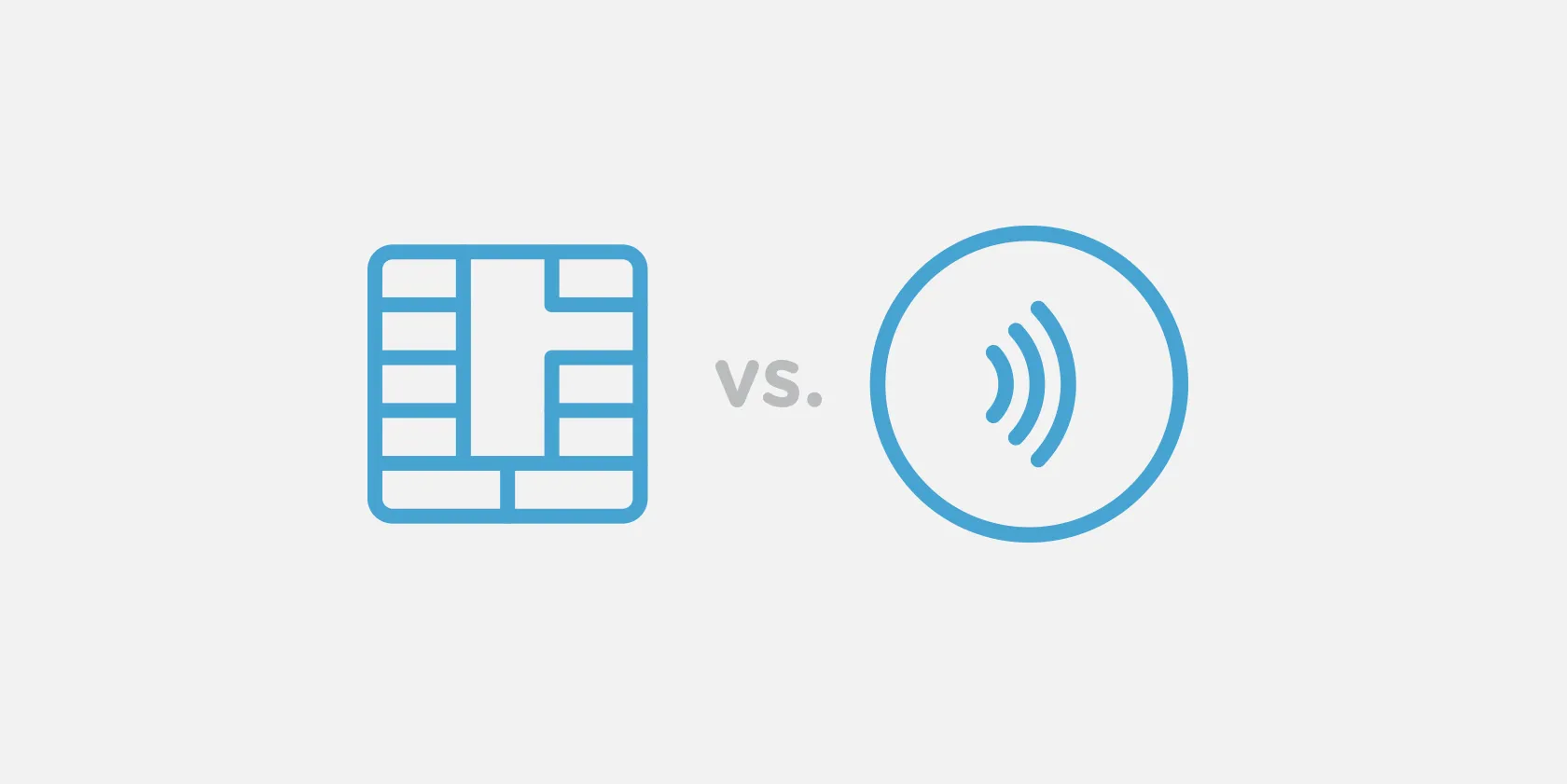Table of contents
Near field communication (NFC) is the technology that allows two devices, such as your phone and a payments terminal, to talk to each other when they’re close together. NFC enables contactless payments. People increasingly use their mobile devices to help manage their day-to-day lives, from email to personal banking to health apps. So it’s no surprise that NFC mobile payments — paying for stuff with your smartphone — are picking up steam. Over time your customers will increasingly want to pay with their phone NFC. To prep you for the sea change, here’s a guide to NFC and how to accept it at your business.
How does NFC work?
NFC is a subset of radio-frequency identification (RFID), a technology that allows us to identify things through radio waves. RFID has been used for decades to scan items in grocery stores, to check luggage on baggage claims, and to tag cattle.
NFC was introduced in the early 2000s, and it uses a specific RFID frequency (13.56 MHz) for close-range communications. To date, NFC has been used with identification cards to gain access to office buildings and private garages. But increasingly NFC is being used to power contactless payments.
If you’ve stood in line at large retailers like Whole Foods, Walgreens, or Office Depot recently, you’ve probably already seen a contactless payment in action. A contactless payment is a transaction that requires no physical contact between a smartphone device and a payments terminal. This means that people can just tap or hover their devices to pay.
How does NFC work on your phone?
When a contactless payment is initiated, a customer’s device must be within two inches of an NFC-enabled point-of-sale system in order to process the payment. The customer’s device and the NFC-enabled reader pass encrypted information back and forth using the 13.56 MHz RDIF frequency. After a few moments the payment is completed.
Speed is one of the coolest parts of NFC payments. These payments are faster than cash, magstripe, and chip card transactions.
The most popular NFC payment apps are Apple Pay, Android Pay, and Samsung Pay. As your customers become more accustomed to paying with their phones, it may be worth investing in a new NFC-enabled payments reader that accepts contactless payments. The Square Reader for contactless and chip accepts both NFC and EMV payments.

The importance of NFC technology in smartphones
NFC technology enables seamless, secure, efficient communication between devices over short distances, which simplifies transactions, data sharing, and connectivity. NFC offers convenience to consumers and reduces the need for physical cards or manual input. Its integration into smartphones supports the growing demand for contactless solutions, which are increasingly important in a world that prioritizes speed and digital transformation.
How to enable and use NFC on iPhones and Android phones
Ready to get started? Here are step-by-step guides on how to use NFC on your phone whether it’s an iPhone or an Android.
iPhone NFC setup
1. Check compatibility: Ensure your iPhone runs on iOS 13 or later. NFC is supported on iPhone 7 and newer models.
2. Enable NFC:
- Open Settings.
- Go to the Control Center.
- Tap Customize Controls.
- Add NFC Tag Reader to the Control Center for quick access.
3. Use NFC for payments: Set up Apple Pay in the Wallet app. Hold your iPhone near an NFC-enabled payment terminal and authenticate with Face ID, Touch ID, or your passcode.
4. Scan NFC tags: Open the Control Center and tap the NFC Tag Reader icon. Hold the back of your iPhone near an NFC tag to read or interact with it.
5. Automate tasks: Use the Shortcuts app to create automations triggered by NFC tags, such as launching apps, adjusting settings, or starting routines.
Note that NFC works automatically for Apple Pay, but manual activation is required to scan NFC tags.
Android NFC Setup
1. Check compatibility: Ensure your Android phone supports NFC (most modern Android devices do including Samsung, Google Pixel, Xiaomi, and Huawei devices).
2. Enable NFC:
- Open Settings.
- Go to Connected Devices or Connections (varies by device).
- Tap Connection Preferences or a similar option.
- Toggle on NFC.
3. Use NFC for payments: Set up Google Pay or another payment app. Hold your phone near an NFC-enabled payment terminal and authenticate with your PIN, fingerprint, or face unlock.
4. Scan NFC tags: Ensure NFC is enabled. Hold the back of your phone near an NFC tag to read or interact with it.
5. Share files or data: Enable Android Beam (if available) in the NFC settings. Open the content you want to share and hold two NFC-enabled phones back to back to transfer data.
6. Automate tasks: Use apps like Tasker or NFC Tools to create custom actions triggered by NFC tags, such as launching apps, toggling settings, or connecting to Wi-Fi.
NFC on Android is versatile and works for payments, data sharing, and automation.
Troubleshooting NFC connectivity issues
If you have difficulty connecting NFC tags to your phone, here are some steps you can take to troubleshoot:
1. Ensure NFC is enabled:
- On iPhone: Check whether the NFC Tag Reader is added to the Control Center (Settings > Control Center > Customize Controls).
- On Android: Verify whether the NFC is toggled on (Settings > Connected Devices > Connection Preferences > NFC).
2. Restart your device: Power off and restart your iPhone or Android phone to refresh the system.
3. Check for interference: Remove phone cases, metal objects, or other devices that may block the NFC signal.
4. Update software: Ensure your iPhone or Android phone runs on the latest iOS or Android version.
5. Test with another device or tag: Confirm whether the issue is with the NFC tag, the terminal, or your phone
6. Reset Network Settings.
If none of these troubleshooting techniques work, reach out to Apple support or your Android device manufacturer for assistance.
NFC tags: What are they and how do they work?
NFC tags are small, wireless devices that store data and communicate with your phone through electromagnetic fields. When you bring your phone close to an NFC tag, the tag is powered by the phone’s NFC reader and transmits its stored information, such as a website link, contact details, or a command. Your phone then processes this data to enable quick actions, such as opening a webpage, pairing devices, or making payments without the need for manual input. This seamless interaction relies on short-range, low-power radio-frequency communication, making NFC tags a convenient tool for fast, contactless payments and other tasks.
Here are some of the most common uses of NFC tags:
- Contactless payments allow for quick transactions via services such as Apple Pay, Google Pay, or Samsung Pay.
- Smart home control, such as turning on lights, adjusting thermostats, or playing music.
- Information sharing, such as Wi-Fi passwords, contact details, or website links.
- Access control to unlock doors, offices, or vehicles with NFC-enabled keys or cards.
- Paying public transport fares or accessing transit systems with NFC-enabled tickets or cards.
- Verifying the authenticity of items, such as luxury goods or pharmaceuticals.
- Automating tasks to launch specific phone functions, such as silent mode or setting alarms.
Is NFC secure?
The idea of paying through phone NFC may make some people uneasy, especially because we’re so accustomed to keeping our wallets close to the vest. But NFC payments are, in fact, more secure than magnetic-stripe cards. While the data on a magnetic-stripe card is static — it’s all right there on the back of your card — the data involved in an NFC transaction is encrypted and dynamic, which means it changes constantly. As an example let’s take Apple Pay, which uses a technology called tokenization to safeguard bank details. Here’s how it works:
- After you take a picture of your credit card and load it into your iPhone (read our detailed guide about how to set up Apple Pay), Apple sends the details to your card’s issuing bank or network.
- The banks and networks then replace your bank details with a series of randomly generated numbers (the token).
- That random number is sent back to Apple, which then programs it into your phone. This means that the account details on your phone can’t be cloned into anything valuable to fraudsters.
What’s more, Apple Pay is protected by Touch ID or Face ID, Apple’s fingerprint and facial recognition technologies. To initiate an Apple Pay transaction, you have to unlock your phone via your fingerprint or face. Even if your device is stolen, no one would be able to get at your data. This is the reason why Apple Pay only works on the most recent iPhone models, which come equipped with Touch ID.
A variety of different NFC-enabled payments are coming to market. For iPhone users, there’s Apple Pay. For Android users, there’s Google Pay and Samsung Pay.
What’s the difference between EMV and NFC?
You may hear EMV and NFC lumped together in discussions. They both represent the next wave of more secure, authenticated payments since they’re both encrypted to protect against counterfeiting. However, EMV and NFC are different technologies.

Europay, Mastercard, and Visa (EMV®) is associated with chip card payments. It was developed and is managed by American Express, Discover, JCB, Mastercard, UnionPay, and Visa. NFC is associated with mobile contactless payments like Apple Pay. Both EMV and NFC are authenticated payments.
Why should I accept NFC?
NFC-enabled payments are the future for three key reasons: they’re secure, fast, and convenient. Let’s dive a little deeper.
Secure
Mobile wallets like Apple Pay tokenize your bank details, meaning they scramble them up into something that’s unintelligible (and thus unusable) for fraudsters. What’s more, these tokens change every time an NFC transaction goes down, so the data is near impossible to isolate and extract.
NFC payments like Apple Pay are also locked down by the fingerprint and facial recognition technology built into the iPhone (you initiate an Apple Pay payment with Touch ID or Face ID). Fraudsters may be tricky, but they can’t replicate your fingerprint or face.
Faster
We mentioned that everyone’s getting EMV chip cards. Which is a good thing, because they’re a lot more secure than magnetic-stripe cards. But what many people don’t realize about chip cards is that EMV transactions are actually pretty slow to process. They’re a lot slower than magstripe transactions, in fact.
What’s happening during an EMV transaction is that the chip in the card is talking with the processor to make sure everything checks out — which is a good thing. But the lag time is pretty noticeable, especially if you have a line waiting.
NFC is the fastest way to pay—transactions take just seconds.
How do you accept NFC?
To accept NFC mobile payments at your business, you’ll need to get set up with an NFC-enabled reader. With Tap to Pay on iPhone and Square Point of Sale or Square for Retail, you can accept all types of in-person, contactless payments right on your iPhone. When customers are ready to pay, they can use a physical credit or debit card enabled for contactless payments, or they can use a digital wallet app, such as Apple Pay, and tap directly on their iPhones to complete the transaction.
![]()











